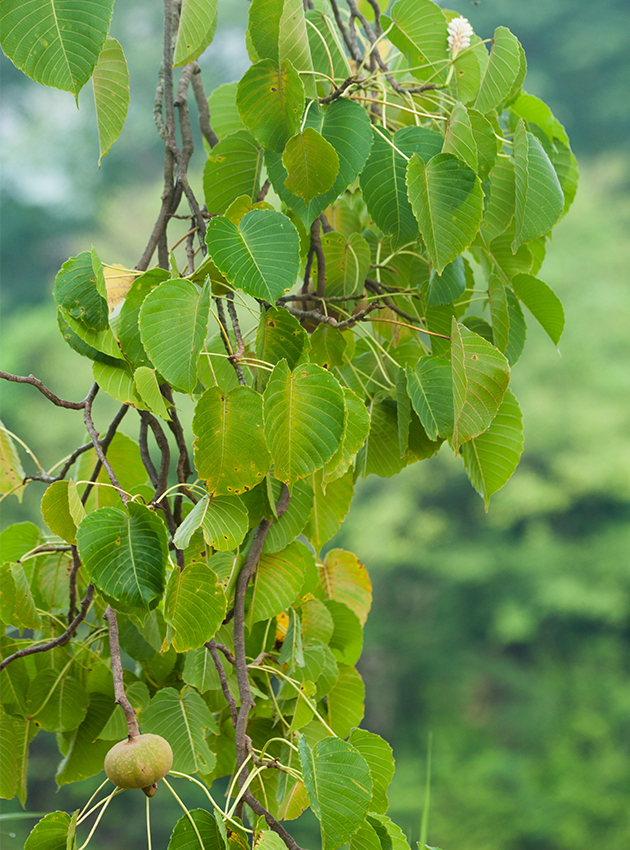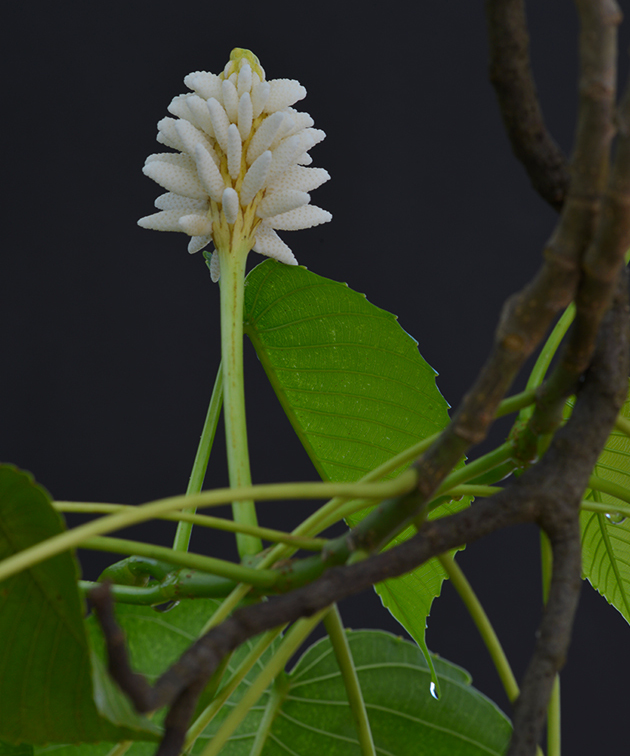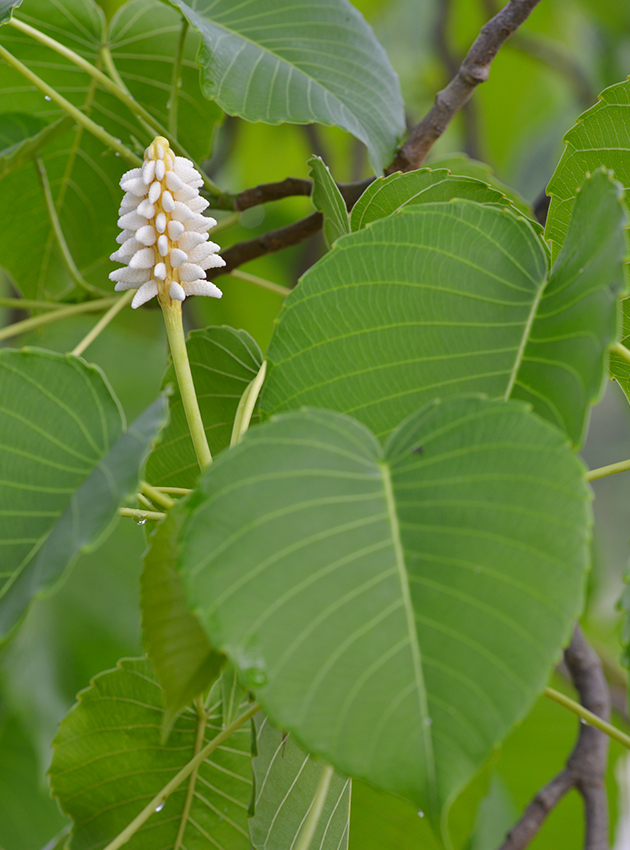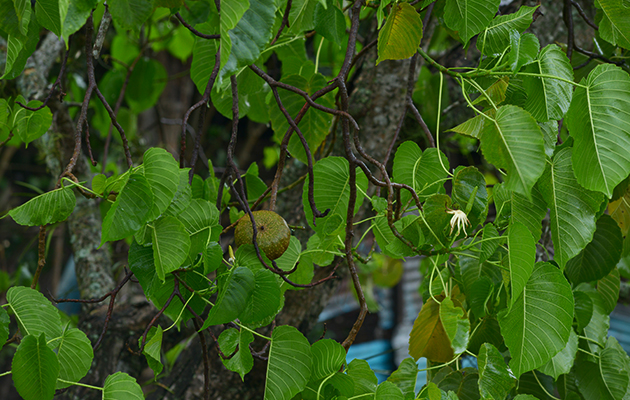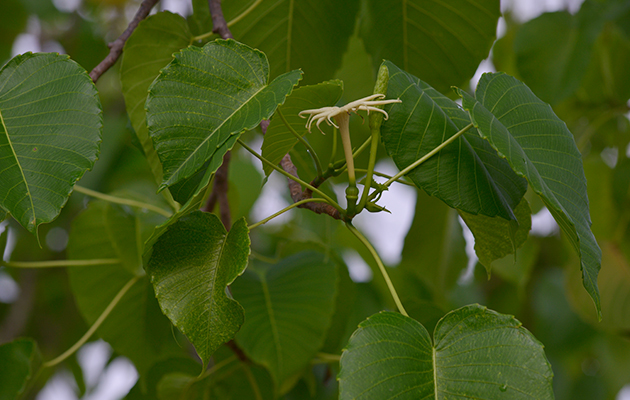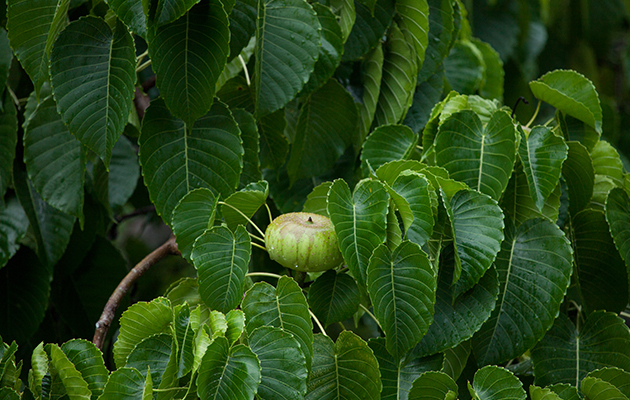My initial interest was a search for trees with conical spines
For the last several years we at FLAAR Mesoamerica have been engaged in a long-range program to ascertain how many trees in Mesoamerica had conical spines which could have been inspiration for the spines on incensarios (incense burners for Copal pom). It is well known that the spines were based on the actual natural conical spines of Ceiba pentandra, the sacred tree of the Maya and still the national tree of Guatemala.
Male Hura polyandra.
But we quickly learned that there are many more trees with conical spines, most obviously other relatives of the Ceiba pentandra, such as Ceiba aesculifolia. The sacred palo de pito has spines, but sharp straight thrones; not the geometric conical spines as on ceiba trees. But other pito, such as pito extranjero (very common 40 minutes drive east of Guatemala City), have bulbous spines.
Year by year, as our research library grew, and as we got more experience out in the forests we found about 15 or more trees, of several botanical plant families, with spines. One of the most intesting was Hura polyandra.
Hura polyandra, photograph by A. Zepeda, Panoramio, photographed in Sinaloa, Mexico; double WOW; this beats any ceiba any day.
Hura crepitans, no location easy to note; thousands of thorns. http://nature.skytopic.org/132365420300-hura-crepitans-le-bois-diable
www.flickr.com/photos/stephenbuchan/2625205759/
But gradually you notice that the spine is more “palo de pito like” and not quite as conical as that of Ceiba. Plus it is the shadow effect which makes it look conical when you see photographs on the Internet. I must admit that when I stood next to the tree I felt a tad disillusioned: spines, yes, but here in Guatemala, only high up the trunk. And none of the trees were as spiny as those in the Internet (which may be because the photos show mainly Hura crepitans; in Guatemala we have primarily Hura polyandra.
A photograph that reveals the true shape (Hura polyandra) is
http://intermountainbiota.org/portal/taxa/index.php?taxon=50602
So far the best drawing I have found is on a Russian web site, and again, Hura crepitans
http://dic.academic.ru/dic.nsf/enc_biology/2300/Семейство
Male Hura polyandra.
Remarkable seed pod
Aside from its legendary venomous sap, what is most impressive is the explosive seed pod. This seed pod, when ripe, explodes with such force (according to sources) that you can hear it from far away and it throws the seeds many meters. I am not sure I would want to handle a ripe pre-explosive seed pod.
Imagine this exploding in your hand!
Best photo is again Flickr, www.flickr.com/photos/museumdetoulouse/4732985832/ There are no photos or videos of it exploding; such a video should win an award if it existed, and if the video photographer lived to send in the clip.
Bizarre flowers
It is a tough decision as which is more unusual: the seed pod size and shape, or the remarkable flower? The day we arrived was literally the last day of flowering for the year. Three years searching for the Hura polyandra tree and I felt lucky to see even two or three flowers (we missed Ceiba pentandra flowering all of 2010, 2011, and 2012! But fortunately we found Ceiba aesculifolia flowering several times in 2012.
Male Hura polyandra.
Location and Habitat
The tree is found from Mexico south through all Mesoamerica, but seemingly only in some ecological niches. Where we finally found it (after three years search) there were dozens and dozens of trees along this river. So surely it is common elsewhere. Indeed in 2014 we were told that lots of Hura trees could be found along a river which crossed under CA9 near the Zacapa area.
Hura, Poisonous yet medicinal!
A lot is written about the medicinal use of Hura leaves. Yet other parts of the tree are poisonous. The sap is the most toxic part. One of many articles is: Envenenamiento con semillas de Hura polyandra (haba de San Ignacio), Dr. Tito Fabricio López Bazán.
Female Hura polyandra.
I would rate Hura polyandra as one of the potentially more toxic trees in Guatemala. Yet it is commonly used as a medicine, by the Aztec and their neighbors (Florentine Codex) and by the Maya (Maximo Martínez).
Uses of Mayan plants
This tree is primarily useful for lumber, or locally for medicine.
Scientific botanical plant name
Hura polandra Baillon is a member of the Euphorbiaceae family. Hura polyandra is in Mesoamerica; Hura crepitans is from Costa Rica to the south (OFI-CATIE, p. 584). For Guatemala they show the entire lowlands, both coasts, with the tree being absent only in the Highlands.
Yet in 50 years in Guatemala I have never noticed this tree, not anywhere.
Local names for Hura polyandra Baillon
- Sandbox tree
- Haba
- Habilla
- Jabillo
In Guatemala trees tend to be called both “masculine” or “feminine” (ceiba or ceibo) depending on with whom you speak.
Female Hura polyandra.
Mayan and Nahuatl language names for Hura polyandra
Zolimanche (haba de san Ignacio) (David Bolles, Yucatecan Maya language). Sorely missing are ethnographers working with linguists working with botanists to prepare easier to understand discussions of the Mayan terms for plants, flowers, trees, fruits and vegetables.
Quauhtlatziln is stated to mean explosive but Quauhtli is clearly stated to mean eagle. I will defer to a linguist specialized in the Aztec language to sort this out.
We continue our research on plants of the Mayan peoples.
It was a challenge to find this Hura polyandra tree in Guatemala. So we can understand why there are not many publications on this species by Maya ethnobotanists or even by local biologists. We have a similar challenge to find many of the other plants in our list. There are over 400 plants on our list of utilitarian species and many trees such as Rosita de cacao we are still trying to find.
We know where Palo de Campeche is (Palo de Tinto): very common, but so far not one single person has been able to alert us when it is blooming so we can photograph its yellow flowers.
As soon as corporate funding or private donations come in, we can find more of the utilitarian plants of the Maya.
Bibliography on Hura polyandra will be in the PDF version
We are preparing a PDF version, since a single web page does not have space for all the photographs.
Hura polyandra.
We have a basic bibliography on Hura polyandra trees on our Mayan bibliography web site, www.maya-art-books.org/bibliography-what-is-about-pre-Columbian-Mesoamerica-plants-medicinal-mayan-ethnobotanical/Hura-polyandra-tree-Jocotan-Zacapa-Guatemala-gardening-plant.php
Most recently updated April 11, 2014 after finding more Hura trees in the Zacapa area.
First posted November 8, 2012.


